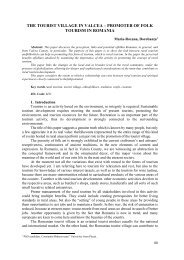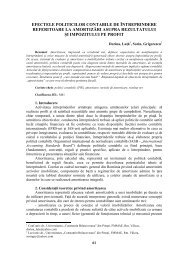equivalence versus non-equivalence in economic translation
equivalence versus non-equivalence in economic translation
equivalence versus non-equivalence in economic translation
You also want an ePaper? Increase the reach of your titles
YUMPU automatically turns print PDFs into web optimized ePapers that Google loves.
strategies of deal<strong>in</strong>g with these cases; the Action Research method br<strong>in</strong>g<strong>in</strong>g together theoryand practice; the corpus-based research method provid<strong>in</strong>g parallel corpora of <strong>economic</strong>terms and last but not least, the case-study research method. Equivalence <strong>in</strong> terms ofcomplete identity would be impossible because languages are different and complexl<strong>in</strong>guistic systems and <strong>translation</strong> takes place not only between languages but also betweentexts embedded <strong>in</strong> complex communicative situations. The professional translator isalways aware of the communicative value of SL-text and its closest equivalent <strong>in</strong> the TL. Ifthe sender decides to write an <strong>economic</strong> text there will be a potential community ofreceivers who belong to the same field and the text is basically addressed to them. Theywould be the first addressees of the text, the readers who can work out most profitably theconveyed content of the message.As the text deals with a specialised topic, the translator needs to possess thel<strong>in</strong>guistic, communicative and textual competences to fully understand its mean<strong>in</strong>g.Afterwards, he/she has to determ<strong>in</strong>e the way the text has been constructed <strong>in</strong> relation to thestylistic, syntactic and lexical characteristics, as well as the semantic, pragmatic andsemiotic peculiarities, which may prove potentially problematic for the <strong>translation</strong> process.Initial <strong>translation</strong> drafts are subsequently reviewed <strong>in</strong> order to verify that all <strong>equivalence</strong>problems encountered have been adequately accounted for. Therefore, the ma<strong>in</strong> task thetranslator faces <strong>in</strong> his work is the establishment of <strong>equivalence</strong>s <strong>in</strong> a cont<strong>in</strong>uous anddynamic problem-solv<strong>in</strong>g process.From our perspective, one cannot know beforehand which text-levels will beactivated as problematic <strong>in</strong> the <strong>translation</strong> process. The fact that <strong>equivalence</strong>s areestablished at text-levels does not mean that they are isolated <strong>in</strong> and restricted to each ofthose levels. The text is to be understood as a complex, <strong>in</strong>terwoven network of l<strong>in</strong>guisticrelations. L<strong>in</strong>guistic choices at the different text-levels are the product of a communicativeevent <strong>in</strong> which an SL-sender and a potential TL-receiver are <strong>in</strong>volved; conditions anddeterm<strong>in</strong>ants (participants’ competences and socio-psychological characterisation, andcontext) have necessarily been taken <strong>in</strong>to account to fulfill a communicative purpose. Thusthey are somehow visible <strong>in</strong> the different language choices present <strong>in</strong> the SL-text. Thetranslator is also embedded <strong>in</strong> this communicative process and when he/she translates, i.e.establishes <strong>equivalence</strong>s, he/she does so by tak<strong>in</strong>g <strong>in</strong>to account aga<strong>in</strong> not only the l<strong>in</strong>guisticmaterial of the SL-text itself but also the conditions and determ<strong>in</strong>ants of the SL-textproduction and those of the TL-text reception.Translation <strong>equivalence</strong> at the word level has been tackled separately only toestablish some major guidel<strong>in</strong>es <strong>in</strong> the <strong>translation</strong> of <strong>economic</strong> texts and to prove thetopicality and applicability of a general theory of <strong>equivalence</strong> and types of <strong>equivalence</strong> <strong>in</strong>the specific case of translat<strong>in</strong>g <strong>economic</strong> texts. Our <strong>in</strong>tention has been to help theprofessional translator solve the <strong>in</strong>evitable <strong>translation</strong> problems which might arise due tothe lack of <strong>equivalence</strong> between the ST and TT. The subsequent types of <strong>equivalence</strong> areyet to be explored <strong>in</strong> order to establish connections and to provide solutions for the<strong>translation</strong> of texts <strong>in</strong> a specialised field such as <strong>economic</strong>s.ReferencesI. Translation Studies1. Baker, M. (1992/2006), In Other Words: A Coursebook on Translation, 2nd edn. Londonand New York, Routledge.2. Bassnett, S. (2002), Translation Studies, 3rd rev. edn. London, Routledge.3. Catford, J.C. (1965), A L<strong>in</strong>guistic Theory of Translation, An Essay <strong>in</strong> Applied L<strong>in</strong>guistics.London, Oxford University Press.4. Danciu, V. (2005), Strategii moderne de market<strong>in</strong>g, Pite ti, Ed. Independen a Economic .5. Gentzler, E. (1993), Contemporary Translation Theories, London & New York, Routledge.81







